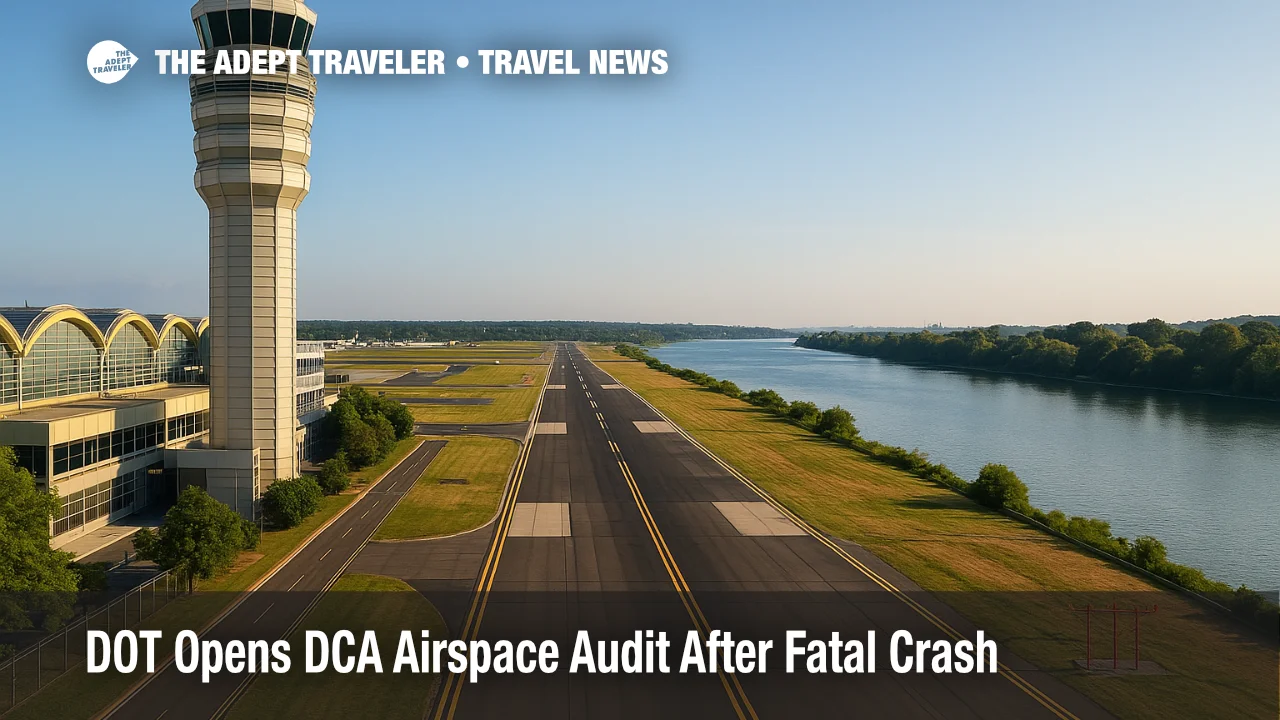DOT Opens DCA Airspace Audit After Fatal Crash

The Department of Transportation's inspector general has launched a DCA airspace audit into the FAA's oversight of Ronald Reagan Washington National Airport (DCA), following the January 29 collision that killed 67 people. The review will examine how the FAA designed and managed airspace near DCA and how federal ADS-B Out exemptions were granted and used. Senators Ted Cruz and Maria Cantwell requested the inquiry in June as part of a broader push to tighten helicopter operations in the National Capital Region. The FAA says it will cooperate fully.
Key Points
- Why it matters: Independent review targets FAA oversight and ADS-B Out exemptions near DCA. * Travel impact: FAA already limited some helicopter activity; more procedural changes could affect arrivals and go-arounds at DCA. * What's next: OIG begins field work this month, then reports findings and recommendations. * Army audit status: No separate Army IG audit announced despite Senate request. * Legislation watch: The Safe Operations of Shared Airspace Act of 2025 was introduced June 5.
Snapshot
The OIG memo cites more than 15,000 close-proximity events between helicopters and commercial flights around DCA from October 2021 through December 2024, underscoring persistent conflict points in one of the country's most complex Class B airspaces. After the January crash involving an Army Black Hawk and American Eagle Flight 5342, the FAA tightened local helicopter operations and, according to Reuters, now requires military helicopters near DCA to transmit ADS-B. Lawmakers want answers on whether airspace design, separation policies, and federal exemptions contributed to the risk profile. The audit will evaluate FAA oversight and the process for granting ADS-B Out waivers.
Background
The January 29 collision occurred as a PSA-operated regional jet approached DCA's Runway 33 while an Army helicopter transited a nearby corridor. All 67 aboard both aircraft died. In March, the NTSB issued urgent recommendations to reduce helicopter traffic conflicts when DCA's intersecting runways are in use and to establish alternative routing, citing unacceptable risk in the current configuration. On March 7, Senator Maria Cantwell wrote Defense Secretary Pete Hegseth questioning the Pentagon's practice of flying without ADS-B Out activated in the National Capital Region. On June 9, Commerce Committee leaders Cruz and Cantwell asked for parallel audits from DOT OIG and the Army IG, highlighting design, separation, and exemption issues. The Army IG has not announced a concurrent review.
Latest Developments
OIG scope centers on airspace design and ADS-B exemptions
The audit will assess FAA management of DCA's airspace and its policies for overseeing ADS-B Out exemptions used by federal operators, including the Army. Investigators will review whether design choices or reduced separation margins contributed to January's crash and how exemptions were granted in Class B airspace. Field work begins this month, with FAA audit liaisons already notified. For readers, the program memo offers the clearest summary of objectives and context. See the DOT OIG audit memo: https://www.oig.dot.gov/sites/default/files/library-items/Audit%20Initiated%20of%20FAA%27s%20Management%20of%20DCA%20Airspace%20and%20ADS-B%20Out%20Exemptions_8.8.25.pdf?utm_source=adept.travel.
Hill pressure grows on ADS-B and Army oversight
Senate Commerce leaders asked both DOT OIG and the Army IG to run concurrent audits after urgent NTSB findings and a May 1 near miss that forced two civilian go-arounds. Reuters reports the FAA later kept Army helicopter flights on hold and now requires ADS-B near DCA. Lawmakers also introduced a bill to mandate broader ADS-B use by the military around civilian traffic. Read the Senate request letter summary: https://www.commerce.senate.gov/2025/6/senate-committee-leaders-call-for-audits-on-dca-airspace-safety-issues?utm_source=adept.travel.
NTSB hearings spotlight systemic gaps
At late-July hearings, investigators detailed altimeter accuracy concerns on the Black Hawk, extensive reliance on visual separation in congested corridors, and long-standing data warning of conflicts near Runway 33. The proceeding capped months of scrutiny that began with March's urgent recommendations to restrict helicopter movements and define an alternate route when runways 15 and 33 are active. Full agendas and exhibits are posted by the NTSB for public review. Hearing overview: https://www.ntsb.gov/news/events/Pages/DCA25MA108-InvHearing.aspx?utm_source=adept.travel.
Analysis
The DCA airspace audit will likely focus on three levers, each with travel consequences. First, geometry, the FAA may revisit helicopter corridors that intersect short-final paths to Runway 33 and adjust procedures that currently lean on visual separation. That could reduce mixed traffic near the river corridor, yet increase helicopter transit times and occasionally prompt airliner go-arounds during runway configuration changes. Second, equipage and policy, standardizing ADS-B activation for non-sensitive military flights near DCA should improve controller and pilot awareness. Reuters reporting indicates the FAA already moved in this direction after the crash, so the audit could cement that stance and define narrow exceptions. Third, governance, expect recommendations on how the FAA manages exemptions, validates risk data, and enforces letters of agreement with the Army. Even modest changes, such as limiting certain routes during specific runway use or codifying ADS-B practices, can lower collision risk without materially reducing commercial capacity. For travelers, the near-term effect may be occasional delay during transitions as new procedures roll out, followed by a steadier operating environment once the rules settle.
Final Thoughts
Washington's airspace is unusually tight, with river-hugging helicopter corridors beside short final approaches at a slot-controlled airport. The OIG review gives regulators a structured path to fix design and oversight gaps that NTSB and Congress have spotlighted. Stronger ADS-B policy and clearer procedures can reduce risk without shutting down essential public safety flights. Travelers may see incremental changes before lasting improvements take hold. The key is translating data into enforceable rules and enforcing them consistently. That is the promise and the test of the DCA airspace audit.
Sources
- Audit Initiated of FAA's Management of DCA Airspace and ADS-B Out Exemptions, DOT OIG
- US agency to probe FAA oversight of Washington airspace after fatal collision, Reuters
- Senate Committee Leaders Call for Audits on DCA Airspace Safety Issues, U.S. Senate Commerce Committee
- NTSB Makes Urgent Recommendations on Helicopter Traffic Near DCA, NTSB
- US senator presses Pentagon to use key safety system in DC-area helicopter flights, Reuters
- Broken altimeter, ignored warnings: Hearings reveal what went wrong in DC crash that killed 67, AP News
